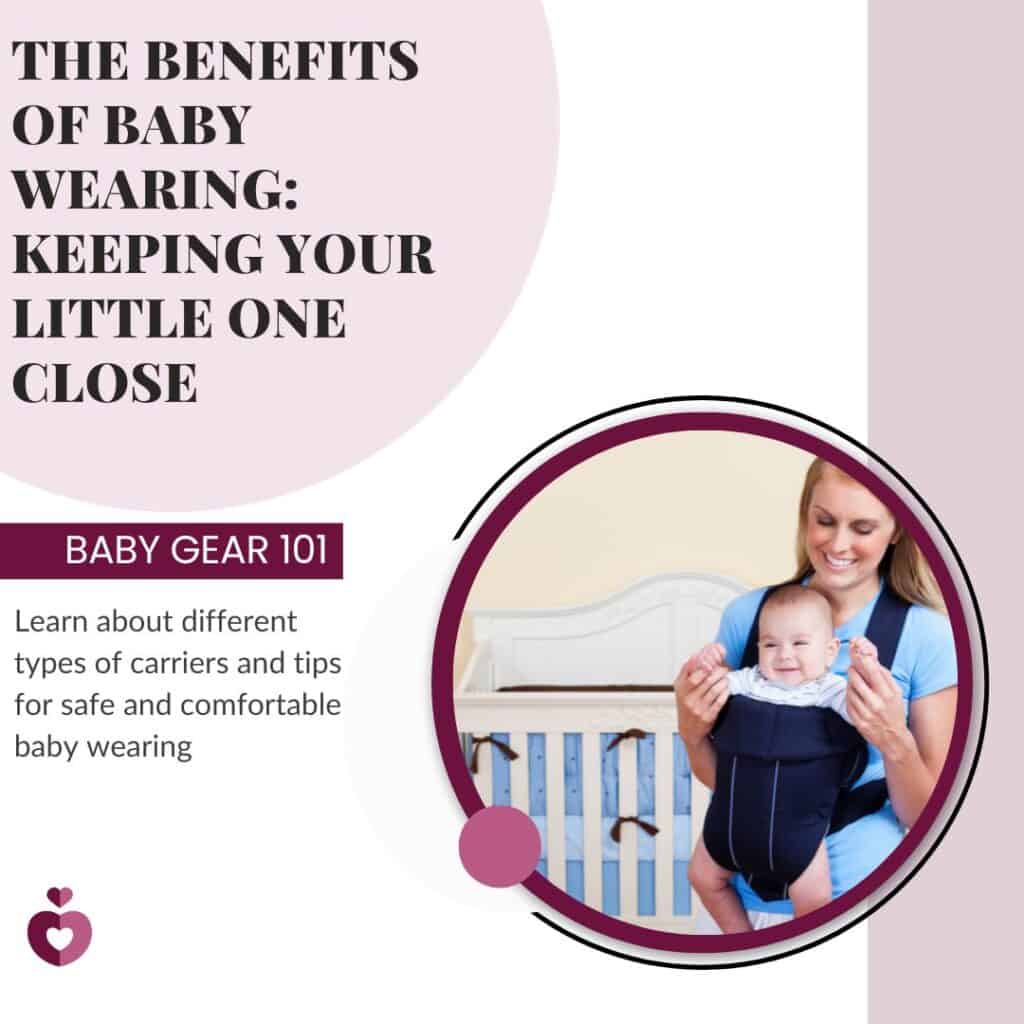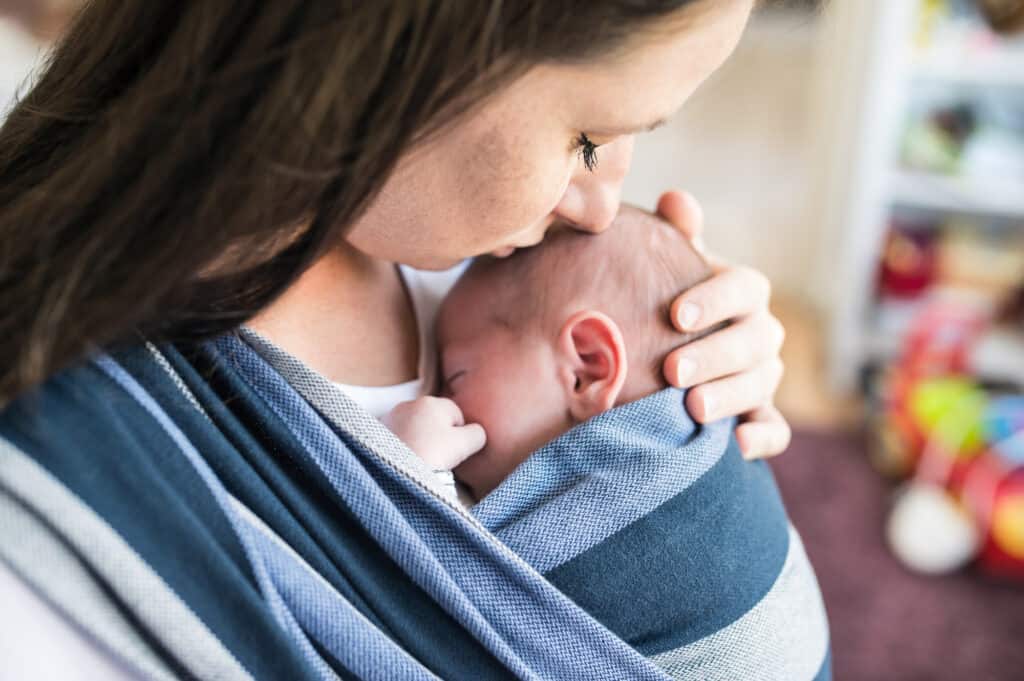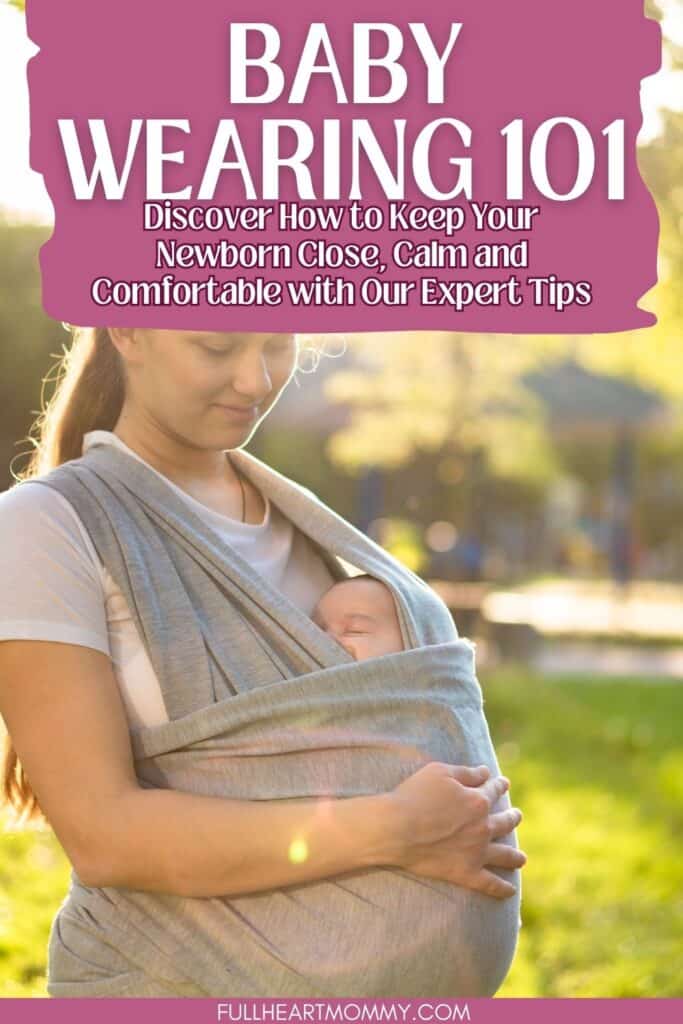Babywearing is a practice that has been around for centuries and is becoming increasingly popular in modern times. It involves carrying or wearing your baby close to your body in either a cloth-type wrap made specifically for this purpose or a structured carrier like an ergonomic sling or backpack-style device.
Babywearing offers many benefits to both parents and babies, including improved bonding between parent and child, increased opportunities for breastfeeding, and greater convenience for the caregiver. It can also help to soothe a fussy baby by providing familiar comfort, security, and closeness.
We will go over how to get started with babywearing; from choosing the right type of carrier or wrap to putting it on in a safe and comfortable way, as well as some tips and tricks.

Choosing the Right Carrier
The first step is to decide which type of carrier you would like to use. There are many different types available on the market today; wraps that are made of breathable fabrics like linen or cotton and structured carriers such as slings, mei tais and backpacks. Each one has its own benefits and features, so it’s important to do your research and find the right one for you.
Soft Structured Carrier (SSC)

Soft structured carriers are designed with buckles and straps that can be adjusted for both comfort and safety. They have padded shoulder straps, waistbands, and sometimes even hoods or pockets for storing items like pacifiers or wipes. When using an SSC make sure to read through the instructions carefully before putting it on. It is also advisable to practice at home without your baby until you feel comfortable putting it on correctly and securely.
Wrap

A wrap is made of long pieces of fabric that can be tied in different ways to fit your body and provide a secure and comfortable support for your baby. They come in many different fabrics, colours and sizes, allowing you to choose the one that best suits your needs. When using a wrap always make sure to use a good knot technique so that it won’t come undone when carrying your little one.
Ring Sling

A ring sling is essentially a long piece of fabric with two rings attached at one end. To put it on, you slip the rings onto either shoulder and then thread the fabric through them. It should be tight enough to securely hold your baby but not too tight as this could cause discomfort. Be sure to read through the instructions before putting on your ring sling to ensure you are using it correctly.
Mei Tai

A mei tai is similar to an SSC, but it often has a flat waistband and four straps that can be tied in different ways for comfort and security. It is important to read the instructions carefully before putting this type of carrier on as well as practice at home without your baby until you become comfortable with the method.
What Are Some Benefits of Baby Wearing?
One of the greatest joys of parenthood is bonding with your baby, and babywearing provides a wonderful opportunity to do just that! With babywearing, you can cuddle close while still having both hands free to multitask – it’s truly a win-win situation!
Not only does this provide beneficial physical contact for your little one, but engaging in skin-to-skin contact has been linked to improved mother/child attachment. Additionally, studies have found that babies who are carried cry less and show an increase in oxytocin levels (the hormone associated with love).
Babywearing also helps promote healthy development in babies by providing them with the security they need during their early months. Being held upright against an adult’s body encourages babies to develop motor skills faster as compared to those that remain stationary most of the time.
Baby wearers often report having more alert and interactive children due to increased opportunities for sensory stimulation such as hearing their parents’ conversations or feeling the warm sun on their face; all things which can aid in communication development later on.
For parents, babywearing offers unprecedented convenience when it comes to tackling everyday tasks like grocery shopping or running errands – no baby stroller needed! It also allows busy moms and dads some reprieve throughout their day while still allowing them quality interaction time with their little ones every step of the way; making outings less stressful for everyone involved.
There seems to be evidence that frequent carrying may reduce fussiness in young babies. Babies who experience periods of sustained crying could benefit from an increased amount of time spent being carried each day rather than being placed in cribs or playpens alone for long intervals throughout the day.
They can also be a lifesaver during the baby witching hour.

How To Choose The Right Baby Carrier
First off, consider your lifestyle when purchasing your baby carrier. Do you plan on utilizing a stroller for trips outside or do you want to use a backpack or wrap style for greater portability?
Are you often out for long walks or hikes? Are trips to crowded places common? Do you have multiple caregivers who will use the same carrier? These types of questions can help point toward what type of carrier may be most suitable for your lifestyle.
Different styles of carriers have pros and cons in terms of comfort, convenience, safety features, breathability, and more — so make sure that the one you choose meets all your needs specifically.
Next up is proper support and comfort – both critical components when it comes to any type of baby-carrying device. The last thing you want is back pain from faulty straps because they don’t properly distribute weight across both shoulders evenly.
Additionally, some carriers may be too bulky or heavy if certain types aren’t designed with support in mind – pay attention to ergonomic elements such as waist belts in order to maintain proper posture when carrying around an infant/child – think adjustable straps that provide snugness yet allow enough room (and freedom) for movement!
Make sure not only yours but also their neck/back area has sufficient cushioning as well; remember babies need extra protection since they can’t hold up their own heads until after four months old at least.
When You Can Start Baby Wearing
You can start wearing your baby from the very beginning, even as a newborn! However, it is recommended to wait until your baby is at least 8 pounds before using a structured carrier. For wraps and slings, you can start using them right away.
Tips for Baby Wearing Success
Proper positioning and fit are key when it comes to baby carrying – babies should sit in a natural position (with their legs wrapped around you) that supports their hips, back, head, and neck. Babies should also always be positioned so that you can see their face at all times.
Start gradually by increasing the time spent wearing your baby in short bursts during the first few days; going too long right away may put a strain on certain muscles like those used to support his/her head or back if they’re not ready yet!
Remember comfort is key when it comes to being successful at babywearing, so listen carefully to your body while in use; do simple stretches before wearing a carrier/wrap/sling each time & take them off after periods of extended wear when feeling any signs of discomfort from either yourself or baby.
If all this talk of walking and movement has got you wondering if can you sit down while babywearing? The answer is yes, you can sit down while baby wearing. As always, make sure baby is supported and that their airway is clear while you are sitting down. You want to avoid slouching and try to make sure you have good posture.
Common Baby Wearing Mistakes to Avoid

It is essential that the child is seated with their bottom low, the legs are bent at the knee and supported so their hips can move freely.
If their legs aren’t properly supported, this could cause hip dysplasia over time. You also want to ensure that they have a wide M-shape position with good spinal alignment.
Additionally, make sure that their head isn’t slumped over – if it is this could reduce air flow and can be uncomfortable for your little one.
It’s easy for babies to become too hot while wearing carriers due to lack of airflow or because mom or dad may have started sweating even more due to physical activity while carrying them around!
Make sure not only that both parties are comfortable with room temperature but also watch for signs such as red cheeks which often means they’ve become too warm!
Most people don’t realize just how dangerous exceeding safety guidelines regarding weight limits etc could be; never exceed what the manufacturer recommends – this includes any limitations on front facing vs back facing positions etc as well (even if certain other parents do).
Does Babywearing Burn Calories?
Yes, you will burn calories – while wearing carriers may allow some more movement than usual (such as walking instead of pushing a stroller) & use slightly more muscle strength in general-this alone will not burn significant calories.
Can Babywearing Delay Crawling?
Not necessarily – crawling generally occurs naturally between 7-10 months however there are some cases where crawling was delayed beyond 12 months while still successfully developing independence later on in life despite being regularly carried from 6 months old onwards.
When to Use Babywearing
Every parent and baby is unique and has different needs and preferences, so it’s important to find what works best for you both.
However, here are some common scenarios in which many parents find themselves turning to babywearing:
Running Errands: When taking your little one out with you for errands such as shopping or visiting friends, using a baby carrier or sling can be a great way of allowing them to get close while keeping their hands free. Baby carriers allow your little one to observe the world around them while being securely held in place; this makes on-the-go exploring much easier!
Doing Household Chores: Many find that having their baby closer not only helps keep them entertained (which we all need help with from time to time!) but allows for multitasking at home whilst bonding with your little bundle of joy. Having a carrier or wrap handy means that you can comfortably move around the house without sacrificing quality time spent together.
Going For Walks Or Hikes: If outdoor adventures are more your thing then perhaps a hiking or walking backpack may work better than traditional slings or wraps! Such backpacks allow kids from the age of 8 months onward to enjoy nature comfortably by either sitting upright or taking a nap – depending on their preference at any given moment. The straps also help distribute weight evenly between caregivers making long hikes possible even when carrying toddlers who want/need an occasional rest break!
And lastly, traveling – whether near or far – has been made infinitely easier with baby wearing. This mode of transport appears increasingly attractive compared to pushing bulky strollers around town (or airport).
Again being able close enough means that parents can keep a closer eye on their child throughout their journey, which is often comforting in unfamiliar environments!
Myths and Misconceptions About Babywearing
Why is babywearing bad?
Well, it’s not. When it comes to babywearing, there can be some hesitation from those who are not familiar with it. I remember when I first started wearing my baby, my older family members were not used to seeing it and were a bit skeptical.
They thought it was uncomfortable, unsafe, and even unnecessary. However, after watching me use it regularly and seeing the benefits firsthand, they slowly began to come around. It’s important to remember that not everyone will understand or even like baby wearing, but as long as it works for you and your little one, that’s all that matters. There’s no need to feel discouraged by the opinions of others.
Can baby wearing cause chest pain?
This shouldn’t be the case but you can experience chest pain and shoulder pain after carrying your baby for extended periods. The physical strain of carrying a baby can irritate your muscles and cause discomfort.
Many parents find that a properly fitted carrier actually relieves pressure on their chest and back. It’s always a good idea to consult with your doctor if you experience any discomfort while baby wearing, but don’t let fear stop you from enjoying this wonderful bonding experience with your child.
Can babywearing help you lose weight?
Babywearing alone is not a guarantee for weight loss – you still need to maintain a healthy diet and consider other forms of exercise. But if you’re looking for a way to incorporate gentle movement into your day-to-day routine while still tending to your little one’s needs, babywearing could be a great option to try.
As we come to the conclusion of our discussion on baby wearing, let’s take a moment to recap some of the benefits we’ve explored.
From bonding with your little one to providing a comforting environment and even aiding in the development, there are endless upsides to strapping on a carrier. But don’t just take our word for it!
We encourage you to try baby wearing for yourself and experience the joy and hands-free convenience that it brings. With so many different styles and types of carriers on the market today, there’s sure to be one that fits your unique needs and preferences. So go ahead, give it a try! You may just discover your new favorite parenting hack.


